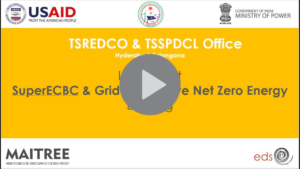
Aug 25, 2021 Technical assistance for pilot Grid Interactive Net Zero Energy Building
India is the third-largest national emitter of GHGs (after China and the United States), and with rapidly rising emissions, India also plays a key role in the international dialogue on climate change as a major developing country. India has announced voluntary targets to reduce the emissions intensity of its GDP by 20-25% against 2005 levels. India’s NDC includes energy efficiency target of reducing the emissions intensity of its GDP by 33-35% from 2005 levels by 2030.
Buildings account for over 35% of India’s electricity consumption. Ratio of electricity use in building sector as a percentage of the annual total has increased continuously in the last four decades. Energy footprint of building sector is expected to grow further since 70% of the buildings that will be needed in 2030 are yet to be built.
MAITREE is working with the State of Telangana on a pathbreaking initiative to reduce the climate change impact of buildings. The first ever Grid Interactive Net Zero Energy Building (GI-NZEB) in South Asia is being built in Hyderabad, to showcase the feasibility and set an example for future buildings to follow. GI-NZEB can be described as ‘highly energy-efficient, grid-connected buildings that meet their energy needs through renewable means, while maintaining a two-way communication with the grid’ to balance demand with electricity supply.
The GI-NZEB will house the offices of the Telangana State Renewable Energy Development Corporation (TSREDCO) and Southern Power Distribution Company of T.G. Limited (TSSPDCL). While the net zero energy building targets a net renewable energy. Through an integrated design process, the project proponents are collaborating to achieve following features:
Performance goals: BEE supported Super ECBC building complaint building design, energy efficient radiant and evaporative cooling system, 90% of area with the required UDI range.
Technologies: The building design will incorporate some of the integrated technologies such as desiccant dehumidification and cooling, integrated natural ventilation, and night flush, IEQ monitoring and control, Individual desktop, and end-use level energy monitoring etc.
LCA approach to goals: Life cycle assessment of materials, HVAC system, lighting, and renewable energy system which reflects the actual carbon footprint associated with the building design.
Grid-Interactive Net Zero Energy: Highly energy-efficient, grid-connected buildings that meet their energy needs through on-site Solar renewable energy, while maintaining a two-way communication with the grid’ to balance demand with electricity supply will make the building the first Grid Interactive Net Zero Energy.
The project is funded by the State government with additional grant from the Central govt for SuperECBC compliance demonstration. USAID MAITREE is providing technical assistance to TSREDCO for the project as a pilot Net Zero Energy Building, with Environmental Design Solutions Pvt. Ltd. (EDS) as the implementing partner. The project process included the following:
- Adopting a Public procurement approach, prepared a detailed draft outlining the requirements for the proposed Net Zero Energy Building to invitation for ‘Expression of Interest’ from prospective architectural firms.
- Shortlisting responsive teams as per the eligibility criteria to be a part of the design competition.
- Preparing a comprehensive RFP, highlighting the requirements of the NZEB design and the competition, was then shared with the shortlisted participants.
- Evaluation of tenders as per their technical and financial bids and selection of architectural firm.
- Technical assistance during implementation, that is peer review of technical inputs for NZEB Design and Green Building Certification through the design development and execution stage.




Sorry, the comment form is closed at this time.